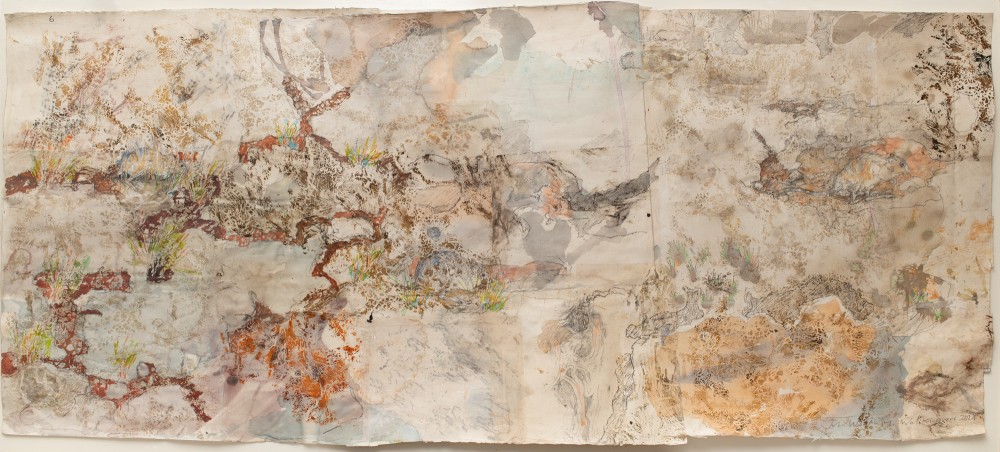
My work over the last 45 years has been a search to discover how we dwell and move within landscape. I have lived and worked all over the continent from the mountains of Tasmania to the floodplains of Arnhem land. I see myself as a hybrid mix of artist and scientist; one who tries to relate the minutiae of the natural world - leaf, feather and beetle wing to the abstract dimensions of the earth's dynamic systems. Using techniques of watercolour, collage, frottage, nature printing and other methods of direct physical or kinetic contact I am finding ways of collaborating with the actual plants, birds, trees, rocks and earth of a particular place.
I like to think that the large works on paper on which I assemble these different drawing methods represent a kind of inventory or document about the state of the earth. I want to reveal both the power and beauty of it, as well as show its condition of critical even terminal change. My interest is to paint the processes and energy fields of the living systems of this land - flocks of birds, or water plants in swamps, or the movement of sand dunes.
Over 15 years I spent a lot of time in the company of the great Yolngu artist Mulkun Wirrpanda painting the floodplains and flora of the Blue Mud Bay region of North East Arnhem Land. In 2017, the results of this collaboration were exhibited at the National Museum of Australia as Midawarr Harvest: The Art of Mulkun Wirrpanda and John Wolseley and formed the basis of a book of the same name.
More recently, at Bendigo Art Gallery from September 9th 2023, I showed work alongside poet Paul Kane and sculpture/video artist, Brodie Ellis. This was a collaborative exhibition of text, image and sound, based on a series of verse essays by Paul Kane. ESSAYS ON EARTH Brodie Ellis, Paul Kane and John Wolseley, 9 September 2023 – 14 January 2024. This immersive exhibition linked the art of poetry to that of painting in a uniquely immersive and powerful way; re-visioning the great Ekphrastic tradition that began in ancient Greece, in which a poem or prose piece interprets or vividly brings to life a work of art.
Over the last three years I have been documenting and painting the habitat and modes of dwelling of mammals, birds and reptiles around my home in the forests of Victoria, and in the deserts of the North. Each June, I have taken my camping truck to the Northern Territory and documented the epic restoration and return of endangered animals to the Australian Wildlife Conservancy’s vast reserves at Watikinpirri/Newhaven. These work will be shown at the Melbourne Art Fair in February 2025.
Australian Galleries, Stand M3 Melbourne Art Fair. 20 -23 February 2025 Melbourne Convention and Exhibition Centre
Image: Burrowing Bettongs return,Watikinpirri 2024 watercolour and relief print on Gampi and Arches paper 86 x 200 cm